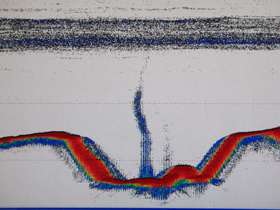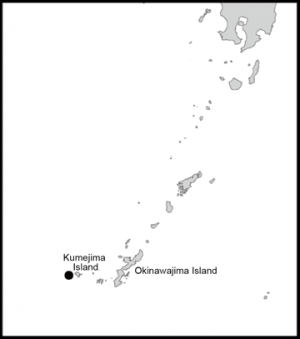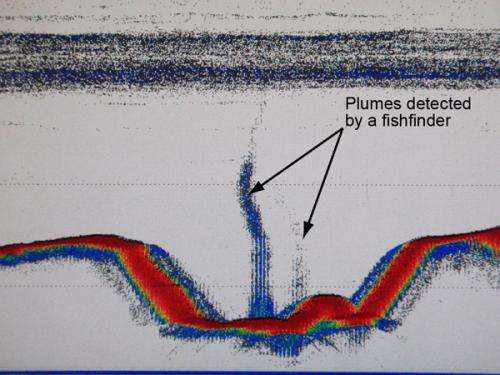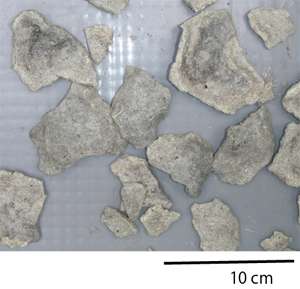Discovery of new submarine hydrothermal activity area off the western coast of Kumejima Island, Okinawa Prefecture

Researchers from National Institute of Advanced Industrial Science and Technology (AIST) conducted surveys of the seafloor off the coast around Kumejima Island, Okinawa Prefecture and Okinoerabujima Island, Kagoshima Prefecture using the research vessel Kaiyo Maru No.7 (499 tons; owned by Nippon Kaiyo Co., Ltd.) from August 20 to September 13, 2012 and discovered a new submarine hydrothermal activity area off the western coast of Kumejima Island. This submarine hydrothermal activity area is located in the caldera of a submarine volcano. Multiple plumes indicating intense hydrothermal activity were observed by acoustic surveys, and in addition, samples that appear to be fragments of chimneys formed in relation to submarine hydrothermal activity were collected. There were also several submarine volcanoes with similar calderas adjacent to this area of hydrothermal activity, and manganese oxide that appears to have been formed from hydrothermal activity was collected from some of these. No submarine volcanoes with caldera topographies or submarine hydrothermal activity areas have previously been known off the western coast of Kumejima Island.
It is possible that submarine hydrothermal deposits have been formed as a result of hydrothermal activity. This new discovery of a marine area potentially containing seafloor resources is very important for planning the development of seafloor resources in Japan. AIST plans to partner with the Ministry of Economy, Trade and Industry and concerned organizations to continue the geological survey of the area.

The development of submarine geological maps as fundamental intellectual information of marine areas around Japan is important for mitigating the damage from natural disasters such as underwater earthquakes. Marine geological maps are also indispensable for advancing the efficient development of seafloor mineral resources. Nowadays, when there is growing uncertainty about supplies of mineral resources, the existence of seafloor mineral resources in Japan's territorial waters and exclusive economic zone is gaining attention. The Japanese government is pursuing surveys and research toward the development of seafloor mineral resources, but a stable, sustainable supply of mineral resources will require collecting and using fundamental intellectual information that will contribute to the discovery of marine areas potentially having new mineral resources.

AIST is continuously making the marine geological maps around the Japanese Islands, and has been surveying the Ryukyu Islands and their surrounding areas since FY2008. A FY2011 survey aboard the Hakurei Maru No.2 (2,127 tons; owned by the Japan Oil, Gas and Metals National Corporation at that time) confirmed multiple submarine volcanoes with calderas in part of the area off the western coast of Kumejima Island (Fig. 1). Because these submarine volcanoes are expected to have seafloor mineral resources, a marine geological survey was conducted on a cruise by the Kaiyo Maru No.7 (GK12 Cruise; Chief Scientist: Takuya Itaki (Researcher, IGG, AIST)) from August 20 to September 13, 2012.

Researchers on GK12 Cruise conducted a submarine topographical survey and a marine geological survey that included collecting rock and sediment samples off the western coast of Kumejima Island. During the surveys, the researchers used a fishfinder and observed multiple plumes indicating intense hydrothermal activity on one submarine volcano with caldera topography measuring several kilometers across (Figs. 2, 3). They also collected sediment samples indicating significant bubble release. Since the plumes observed by the acoustic records arose close to the sites where sediment samples with signs of bubble release were collected, there is a strong possibility that these plumes include a large amount of bubbles. The researchers also observed seawater turbidity anomalies within the caldera and collected possible chimney fragment samples with hydrogen sulfide odor (Fig. 4). These results suggest intense hydrothermal activity in the caldera.
Previous marine geological surveys have confirmed the existence of manganese oxide formed by hydrothermal activity at nearby submarine volcanoes. These indicate the possibility that hydrothermal activity exists in other calderas besides the caldera where the hydrothermal activity was recently discovered, and suggest that multiple submarine volcanoes are active and that there is submarine hydrothermal activity there.
The following analyses are currently proceeding on the samples collected during GK12 Cruise.
1) Submarine topographical analysis
2) Mineral and chemical analyses of rock and sediment samples collected
3) Determination of age of rock samples
4) Analysis of gas composition in sediment samples

The results of the recent survey show that there is submarine hydrothermal activity in the submarine volcano zone off the western coast of Kumejima Island. Because submarine hydrothermal activity is expected to lead to the formation of ore deposits, AIST plans to conduct surveys and research on the distribution, range, and activity pattern of the submarine hydrothermal activity and the possibility that ore deposits exist, in close collaboration with the Ministry of Economy, Trade and Industry and the Japan Oil, Gas and Metals National Corporation.
Provided by Advanced Industrial Science and Technology


















